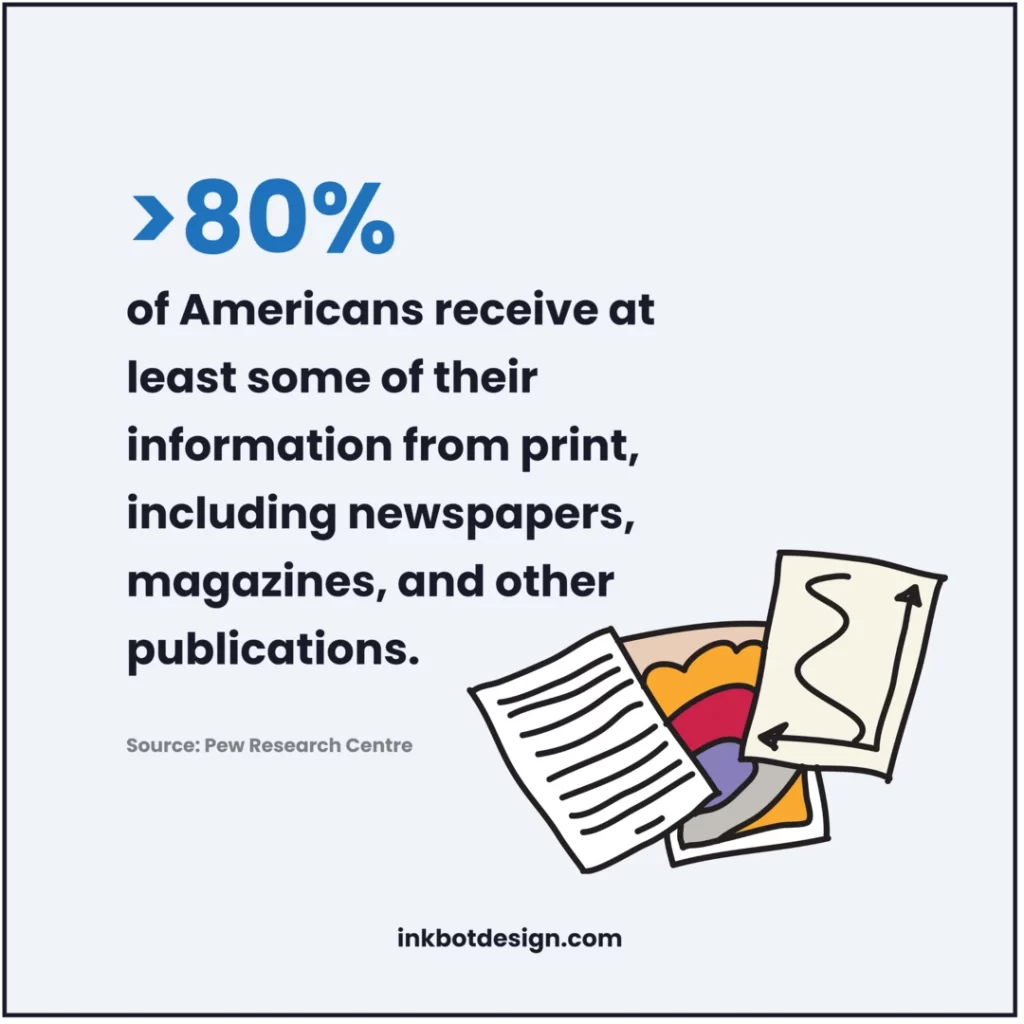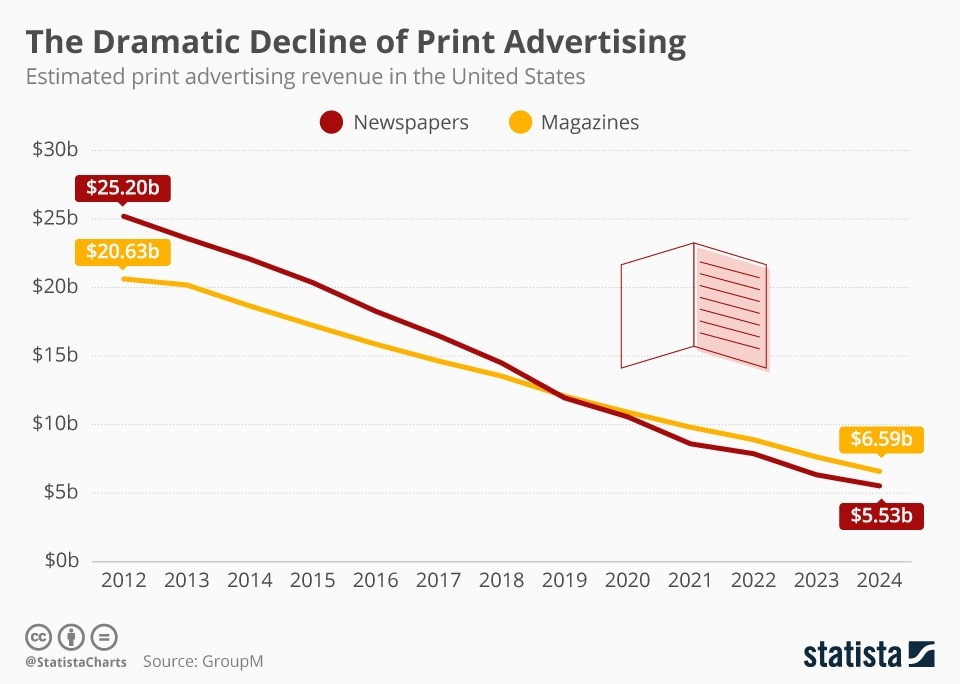Why Print Advertising Still has a Place in the Tech Era
When considering the digital revolution, people often think print ads are dead. Traditional print advertising is fading, but it's true that it still exists in today's tech-driven era. Print ads are still a great way to reach people who aren't online, and many of these are also great ways to build brand awareness.
The world is changing fast. In many ways, the digital age is upon us. But what about the good old days when magazines ruled the newsstands, TV was king, and newspapers were everywhere? If you're an advertiser, you can still get your message heard. Yes, print advertising still has a place in the technology era. But you must know the ins and outs of print media to create the most effective ad campaign you can.
Today's consumers are tech-savvy and mobile-obsessed, and the world has never been busier or more connected. But when it comes to traditional media, we're still spending an inordinate amount of our time reading, watching and listening to what's being published, said, broadcast or streamed.
With over 5 billion people online, and a massive increase in smartphone ownership, the opportunity to reach them is greater than ever. And yet, print advertising still has a place in the tech era.
Table of Contents
What is Print Advertising?

Print advertising refers to the advertising methods used in newspapers, magazines, books, radio, and television. You can also see advertising on billboards and bus shelters.
Advertising is the act of communicating with consumers using print media. The primary purpose of this kind of advertising is to attract the attention of the reader and the listener. That is why choosing a medium that will reach the right audience is essential.
In addition, when choosing a medium to be used in your advertising, you need to pay attention to the fact that the medium should be adequate. It is also essential that you pay attention to the cost of the advertising medium. For example, some companies spend a lot of money advertising in a national newspaper.
Advertising in newspapers or magazines is very effective, but it is not cheap. So, make sure you use a suitable medium for your business.
Some other very important facts are the time that it takes to advertise. You should consider the time it takes to print the newspaper, prepare the advertisements, and deliver them. It will be easier to calculate the cost of advertising if you know the exact number of impressions you will get from each medium.
Print Advertising Methods
There are many ways to advertise your products or services. The most common way is print advertising. It is one of the oldest advertising methods that has been around for centuries.
It is easy to use, and it is inexpensive. That is why many people think that it is the best medium. It is an excellent way to market your business because it is very informative and easy to read.
But it is a mistake to believe it is the only way to advertise. Some people think that everything on TV is advertising, but that is not true.
For example, when looking for a place to eat in your city, you might want to see the menu or visit the restaurant. This is something that you would not see on TV.
It would be best if you chose the correct medium for your business. For example, if your business is located in the country, you would probably want to use print advertising.
Why Is Print Advertising Still Important?

While television is the primary source of advertising in the US, print still plays a prominent role. More than 80% of Americans receive at least some of their information from print, including newspapers, magazines, and other publications. That's a larger share than for any other form of media.
According to a recent Pew Research Centre study, people who receive their news via digital platforms (e.g., websites, podcasts, etc.) are more likely to have lower levels of trust in the news. While digital sources provide a wealth of information, they lack the authenticity and depth of content provided by traditional media, such as television and print.
Print advertising is less expensive than television, radio, and other online formats. So, even though the overall reach of traditional media is declining, print advertising remains an essential part of our information landscape.
Where Does Advertising Fit In?
Print advertising includes newsprint, periodicals, flyers, booklets, brochures, and other printed materials. It accounts for almost one-third of the US advertising budget and nearly two-thirds of all consumer advertising. Television advertising accounts for about one-quarter of the US advertising budget, while radio advertising comprises about a quarter of the total.
Advertising on a digital platform isn't new. But when the internet took off, it offered fewer options for advertisers, so they largely stuck to television. With the explosion of digital platforms and the rise of social media, print is once again becoming a popular option for advertisers.
Technology has made a big difference in print advertising
Print advertising was costly and labour-intensive when the first newspapers came out in the early 1700s. If you wanted to advertise something, you had to purchase and distribute flyers or posters, and even those were expensive.
For example, a flyer for a new movie might cost around $6 to produce and distribute, and it could only be handed out a few times per week. A poster could cost between $3 and $10 and be posted up to eight times per week. To make things even more expensive, flyers and posters had to be delivered by mail, and they took days to arrive, usually taking a minimum of five days to get to your customers.
In addition, they weren't very good at getting people's attention. Flyers and posters were only used if they were mailed out or handed out at a store or restaurant. If you wanted your customers to read or see your ad, you'd have to go door-to-door or post it somewhere people would notice it.
It would take months of effort and hundreds of dollars to reach your intended audience, and you could be guaranteed that most people wouldn't see your ads.
The fact that print advertising wasn't very effective led to the creation of more modern forms of media, like television and radio.
Today, however, print advertising is back with a vengeance. Statista says the average annual spend on print ads is over $90 billion, and digital marketing accounts for just 10% of the total. Print advertising is more effective at driving direct sales and is a powerful part of any marketing plan. It also allows brands to speak directly to their target customers, giving them a personal, one-on-one connection.
While the benefits of print advertising are plentiful, some drawbacks make it challenging for brands to achieve the desired results. While television and radio are considered more passive mediums, print is considered more of an active medium, meaning that people respond to it more quickly, and it's more difficult to ignore than other forms of media.
Print advertising can be a great way to reach your targeted customers, but you'll need to be prepared for some challenges. For example, print ads are typically limited to one or two text columns, so you'll have to be concise and clear. They're also more expensive than online ads, which makes print advertising less cost-effective than it once was.
Still, we shouldn't overlook the power of print advertising. Many brands are choosing to go back to this traditional form of media to reach their customers and make an impact.
Print ads are an effective tool for direct marketing

We think print is one of the best advertising vehicles available to marketers. When done well, it cost-effectively reaches a large audience.
But with the rise of digital advertising, print is losing some of its appeal.
Advertising has become more complex as marketers try to build more customised messages for their audiences. The result is that marketers are turning to technology to help them create targeted advertisements.
Some of these technologies include programmatic ad buying, advanced targeting and behavioural data, and mobile-optimised ads. These technologies enable marketers to reach specific audiences and efficiently use their advertising budgets.
Print ads are still effective, in any case. According to a study from Nielsen, only 2% of consumers view print ads online. However, print ads tend to be more engaging because they're effective in the first place: they are tangible, and customers respond better to tangible things.
Advertising is changing, and this change is creating opportunities for print. But it's also challenging traditional print ads. Innovations and technological advancements are making print ads more relevant and impactful than ever.
Print ads may be the most effective way to market to the millennial generation. According to Kantar Millward Brown's research, millennials spend more advertising budgets on print than other generations. This can be attributed to print ads being more tangible and engaging.
The millennials are also more connected than previous generations. They are more likely to get their news and information from digital platforms. They're also more connected and more willing to engage with businesses that can meet them where they are online.
This suggests that print ads could be more effective than traditional ads on social media. In a study of millennials' digital habits, researchers found that print ads are more likely to be shared on Facebook and Instagram than digital ads. This makes sense because print ads are more personal and interactive, and people like interacting with people.
In addition, Millennials are more likely to read print ads than other age groups, which could translate to increased brand awareness and engagement.
Another trend is the rise of visual content marketers.
While it may seem like video is replacing text in marketing, it's not simple. Text is still fundamental. The visual content marketer is responsible for creating graphics and imagery used in digital and print ads. They design images, infographics, and videos that can help brands communicate effectively with their audiences.
Visual content marketers create branded materials, including packaging, collateral, and events. They often produce creative elements that are integrated into brand campaigns.
Print ads may not replace digital ads but have a place in the mix.
How is the Print Advertising Industry Doing?

As you probably know, many advertising agencies offer businesses to print and online marketing services. In recent years, many agencies have started using new digital platforms to reach customers through mobile devices like smartphones and tablets. This new digital strategy has created many challenges for agencies and clients alike. Here are some of the issues related to the print industry.
1 – Mobile Device Growth
One of the most significant issues facing print advertising agencies today is the growing number of people who use smartphones and other mobile devices to access the internet. According to statistics, 84% of US adults use the internet on mobile devices. Every person has a smartphone, but only half of all Americans own a laptop computer. So, the amount of people using mobile devices to access the internet is multiplying.
2 – Low Click-Through Rates
Another issue facing print marketing agencies is the low click-through rate of ads. According to the most recent statistics, about 10% of internet users in the United States click on links in text-based advertisements. Compare this to the 40-50% rate of click-through rates that can be expected from television and radio ads. This indicates that most people don't read ads on their phones and tablets, leading to the poor performance of many print campaigns.
3 – Declining Print Circulation
While many media outlets are shifting their focus away from print, advertising agencies are still responsible for producing and distributing print ads to newspapers, magazines, and other publications. The fact that so many advertisers rely on print to reach customers is the reason for the continued growth in the industry.
4 – Shrinking Budgets
As more people use mobile devices to access the internet, advertising budgets are shrinking. Many agencies and print advertisers have had to cut their budgets and spend less on print campaigns. The result has been decreased print publications and a decline in print circulation.
5 – Low Engagement
Despite all the problems facing the print advertising industry, the number of people engaged by print ads is increasing. According to the recent Ad Age Data Center, 73% of Americans are interested in print. This is a much higher percentage than what is reported for television and radio ads. However, there is still a great deal of work to get more people to engage with print ads.
6 – High Cost of Production
While there is some truth to the idea that print ads are more affordable than online ads, there are still costs associated with printing and distributing print ads. In addition, the cost of print production has increased over the past few years. As a result, many print ads are more expensive than online ads.
7 – Declining Advertising Sales
With fewer and fewer advertisers showing interest in print, it is not surprising that print ad sales are also declining. According to the latest statistics, the average revenue per thousand spent on print ads decreased to $8.48 in 2022 from $10.05 in 2021. The decline in ad sales has led to a reduction in print media publications.
Despite the growing number of mobile device users and the decreasing number of print publications, the print advertising industry is still very much alive. However, it has been hit hard by the digital revolution. New advertising strategies must be employed to reach more consumers, and the number of print publications and their circulation must be maintained.
Print ads should continue playing a vital role in business communications, but they must adapt to the digital world. The future of print advertising is bright, but agencies and publishers must work together to create and distribute the best ads.
Types of Print Ads that Work well

More than 90% of consumers say they read print ads, and most surveyed say they prefer to read print ads over digital ads. Print ads are still widely used, and many brands continue using them for marketing and customer service.
The most common type of print advertising is editorial advertising. Editorial print ads offer a news or feature story about the product or brand. For example, a car ad might include a short article about the features of the model being promoted.
Another popular form of print advertising is classifieds. Classifieds are often used for local businesses or products and services. The term refers to any advertisement in a newspaper or magazine by a business offering a specific product or service.
The third most popular type of print ad is informational, such as a brochure or other information about a product or service. An image of the actual item usually accompanies these types of ads.
Finally, ads that promote a sale are called direct mail. These ads appear in print publications, on television, or the internet. Direct mail advertising allows the consumer to purchase the advertised item immediately.
Wrapping Up
It may seem like we live in an age where everyone can access a phone and order goods and services online. But while that might be true, it still isn't true for everyone.
Some people prefer to buy things in person or aren't comfortable online. So even though the digital world is thriving, print advertising will always play a role in marketing for many companies.
You see, most people still need to be able to touch and feel the products they're buying. They need to see pictures, read descriptions, and perhaps even hold them in their hands before they decide to purchase.
If you want to learn more about how to start a successful business in your industry, check out my free resources!
Print Advertising FAQs
Why is it important to advertise in print?
Print advertising is vital because it is the most effective way to reach a broad audience. For example, a magazine advertises a new diet plan. The magazine will reach many people, and it will be easy for them to remember what it says about the diet plan. This is why print advertising is so popular.
How does a company advertise with print?
A company can advertise with print by using various methods. They can buy an ad in a publication, they can pay for a space in a publication, or they can pay to have their message placed in a publication.
How much does print advertising cost?
The cost of print advertising depends on the size, the type of publication, and the advertisement's length.
What do you think makes print advertising so effective today?
The answer to this question depends on the age of the person asking it. Print advertising is still effective for younger generations because they can read the advertisements without the internet or social media distracting them.
What do you think makes print advertising different from other advertising forms?
Print advertising differs from other forms of advertising because it's still one of the most popular. In the future, it's possible that people won't even be interested in seeing print ads, but they will still be interested in reading them.
What kind of print ads are there?
There are two types of print ads: display and non-display. Display ads are the ones you see when you walk into a store. These are the ones that are on the wall and the magazine covers. Non-display ads are the ones you see when you walk into a store. These are the ones on the back of magazines and the inside pages.
